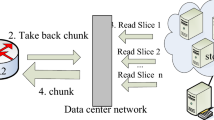Abstract
We propose an adaptive method and a vector algorithm for assessing the main characteristics of traffic in high-speed multiservice communication networks. The adaptive algorithm for assessing the characteristics of network traffic operates online. The method is based on the conditionally nonlinear Pareto-optimal filtering principle, in which the estimation of the unknown traffic parameters is performed in two stages. At the first stage, we estimate the value of the latest forecast function of unknown traffic parameters, and at the second stage, the forecast is corrected. An analysis of the research results for the method and algorithm proposed for assessing the main characteristics of traffic in high-speed multiservice communication networks has shown their high efficiency. The average relative error of the resulting estimates does not exceed 10% of the current values of the traffic characteristics being estimated.






Similar content being viewed by others
REFERENCES
ITU-T Recommendation Y.2001. General Overview of NGN, Geneva: ITU, 2004.
ITU-T Recommendation Y.2011. General Principles and General Reference Model for Next Generation Networks, Geneva: ITU, 2004.
Gol’dshtein, B.S., Sokolov, N.A., and Yanovskii, G.G., Seti svyazi. Uch. dlya VUZov (Communication Networks. A University Handbook), St. Petersburg: BKhV Sankt-Peterburg, 2011.
ITU-T Recommendation G.1000. Communications Quality of Service: A Framework and Definitions, Geneva: ITU, 2001.
ISO/IEC 27001. Information Technology—Security Techniques—Information Security Management Systems—Requirements, Switzerland: ISO/IEC, 2005.
Simonina, O.A., Models for calculation of QoS indicators in next generation networks, Cand. Sci. (Eng.) Dissertation, St. Petersburg, 2005.
Shelukhin, O.I., Osin, A.V., and Smol’skii, S.M., Samopodobie i fraktaly. Telekommunikatsionnye prilozheniya (Self-Similarity and Fractals. Telecommunication Applications), Moscow: Fizmatlit, 2008.
Ageev, S.A., Gladkikh, A.A., Kurnosov, V.I., and Privalov, A.A., An adaptive method for detecting traffic anomalies in high-speed multiservice communication networks, Naukoemkie Tekhnol. Issled. Zemli, 2019, vol. 11, no. 5, pp. 4–13.
Ageev, S.A., Saenko, I.B., and Kotenko, I.V., A method and fuzzy-inference based algorithms for detecting anomalies in the traffic of multiservice communication networks, Inf.–Upr. Sist., 2018, no. 3, pp. 61–68.
Tikhonov, V.I. and Kul’man, N.K., Nelineinaya fil’tratsiya i kvazikogerentnyi priem signalov (Nonlinear Filtering and Quasicoherent Signal Reception), Moscow: Sov. Radio, 1975.
Pougatcheff, W.S., Generalization of the theory of conditionally optimal estimation and extrapolation, Dokl. Akad. Nauk SSSR, 1982, vol. 262, no. 3, pp. 535–538.
Pougatcheff, W., Conditionally optimal filtering and extrapolation of continuous processes, Autom. Remote Control, 1984, vol. 45, no. 2, pp. 212–218.
Sinitsyn, I.N., Fil’try Kalmana i Pugacheva. Uch. pos. (Kalman and Pougatcheff Filters), Moscow: Univ. Kniga–Logos, 2006.
Polyak, B.T. and Tsypkin, Ya.Z., Pseudogradient adaptation and training algorithms, Autom. Remote Control, 1973, vol. 34, no. 3, pp. 377–397.
Polyak, B.T. and Tsypkin, Ya.Z., Optimal pseudogradient adaptation algorithms, Autom. Remote Control, 1981, vol. 41, no. 8, pp. 1101–1110.
Takagi, T. and Sugeno, M., Fuzzy identification of systems and its applications to modeling and control, IEEE Trans. Syst. Man Cybern., 1985, vol. SMC-15, no. 1, pp. 116–132. https://doi.org/10.1109/TSMC.1985.6313399
Piegat and , A., Fuzzy Modeling and Control, Berlin–Heidelberg: Springer, 2001. Translated under the title: Nechetkoe modelirovanie i upravlenie. 2-e izd., Moscow: BINOM. Lab. Znanii, 2013.
Wooldridge, M. and Jennings, N., Intelligent agents: theory and practice, Knowl. Eng. Rev., 1995, vol. 10, no. 2, pp. 115–152. https://doi.org/10.1017/S0269888900008122
Wooldridge, M. and Jennings, N., Agent theories, architectures and languages: a survey, in Intelligent Agents: ECAI-94 Workshop on Agent Theories, Architectures and Languages (Amsterdam, The Netherlands, August 8–9, 1994), Wooldridge, M. and Jennings, N., Eds., Berlin: Springer Verlag, 1995, pp. 1–22.
Intel Corporation website. https://www.altera.com. Accessed November 18, 2019.
Open Cores website. http://opencores.org/projects. Accessed November 5, 2019.
Author information
Authors and Affiliations
Corresponding authors
Additional information
Translated by V. Potapchouck
Rights and permissions
About this article
Cite this article
Ageev, S.A., Privalov, A.A., Karetnikov, V.V. et al. An Adaptive Method for Assessing Traffic Characteristics in High-Speed Multiservice Communication Networks Based on a Fuzzy Control Procedure. Autom Remote Control 82, 1222–1232 (2021). https://doi.org/10.1134/S0005117921070067
Received:
Revised:
Accepted:
Published:
Issue Date:
DOI: https://doi.org/10.1134/S0005117921070067




